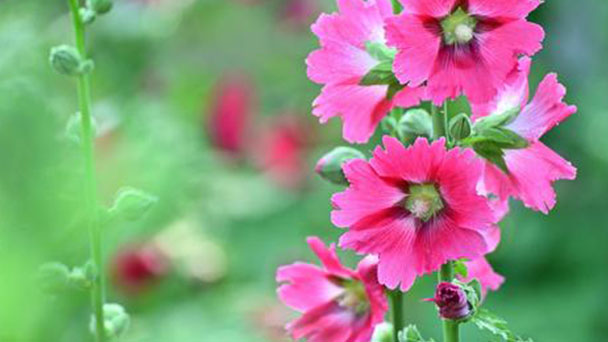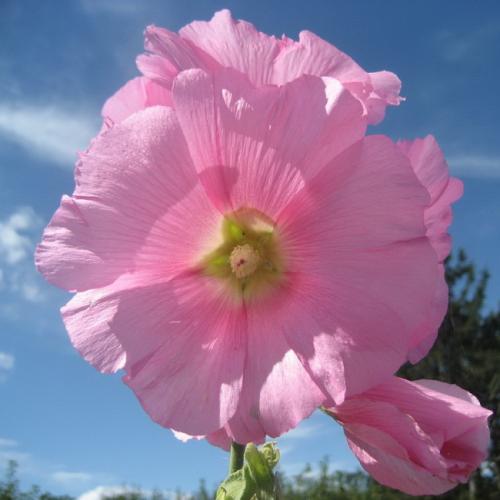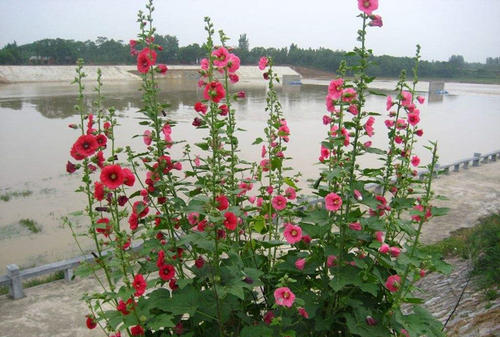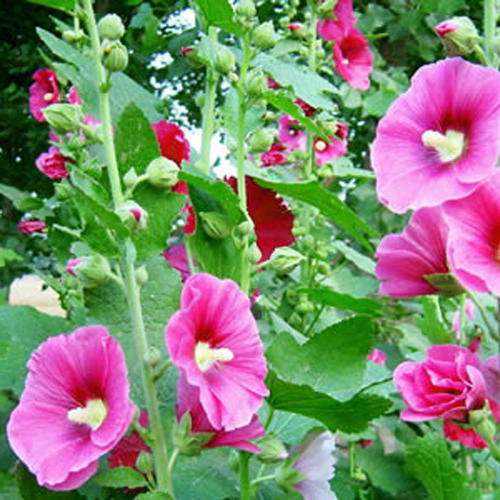How to Grow and Care for Common Hollyhock
Written by Maggie
Nov 19 2021

Common hollyhock is a perennial herb with red flowers, hence its name. Home in the middle of the more common is planted in the courtyard, but also beside the building, rockery or embellishment of flower beds, lawn, row or cluster planting, the effect is very good-looking. So how does Common Hollyhock grow? The following is about Common Hollyhock growing methods and Common hollyhock care.

Common Hollyhock's growing methods
Best growing time: Generally in the spring and autumn suitable.
Best growth soil: Deep soil layer, fertile, well drained soil.
Growth humidity requirements: Common hollyhock flowers like full sunshine, resistance to half shade, but avoid waterlogging.
The best growth temperature: common hollyhock growth temperature is 25~30 degrees Celsius, the most suitable temperature for flowering period 26~28 degrees Celsius.
Best Growing Light: Common Hollyhock loves the sun and tolerates semi-shade, but grows best in full sun.
Common Hollyhock's growing method of soil culture:
The soil culture management of hollyhocks is relatively simple. When the seedlings grow 2 to 3 true leaves, they should be transplanted once and the row spacing of plants should be increased. After transplantation, there should be timely watering. Before flowering, combine with tillage weeding application of topdressing 1 to 2 times, topdressing with phosphorus, potassium fertilizer as well. Seedlings can be transplanted in November after one transplant. In the seedling growth period, apply 2-3 times of liquid fertilizer, mainly nitrogen fertilizer. At the same time often loose soil, weeding, in order to facilitate plant growth robustly. When the flower buds formed in the leaf axils of hollyhocks, phosphorus and potassium fertilizer were applied once. In order to prolong the flowering period, adequate water should be maintained.

Common Hollyhock care
Fertilizing care
Top dressing with phosphorus, potash fertilizer as well. Seedlings can be transplanted in November after one transplant. Seedling growth period, 2-3 times of liquid fertilizer, mainly nitrogen fertilizer. At the same time often loose soil, weeding, in order to facilitate plant growth robustly.
Watering care
In the Common Hollyhock flowering period, it should be properly watered, in order to promote a long flowering period, good flowering, open until the top of the stem. And the general summer morning and evening watering is more appropriate.
Common Hollyhock should shoot the trunk in the spring to promote branching and dwarf the plant.
Basin soil care
It is recommended to replace it every year or every other year, and occasionally lose the soil to allow it to breathe.
Propagation points
Common Hollyhock has three main propagation methods; That is, dividing, cutting and sowing method.
Common Hollyhock pests prevention
Few diseases and insect pests occur, even if the occurrence of diseases and insect pests, will not endanger the dieback. The pests to be controlled are:
1. Cinnabar mite: Often occurs in the middle and late May, when the occurrence of leaf surface there are many gray white small spots, mites in the back of the leaf harm. During the occurrence period, it can be controlled by spraying 40 dichlorophenol emulsion 1 000 ~ 1 500 times liquid, or 4 cm dichlorophenol emulsion 1 500 times liquid.
2. Cotton leaf roller: Commonly known as leaf roller. Larvae will roll the leaves into a cylinder and dive inside the cylinder to eat leaves, seriously when the leaves can be eaten up, only the coarse and hard veins. Occurrence period is more in the middle of June, late July, late August.
Prevention and control methods:
A small number of available artificial killings.
50 aerosol emulsion was sprayed with 2 500 times liquid for control. In addition, sometimes may have aphid (cotton aphid) occur, its natural enemy can inhibit its serious harm generally.

Latest Updated
- Benefits of Bugleweed - 7 Science-backed Health Benefits
- Bugleweed Dangers & Side Effects - Is It Poisonous?
- How to Plant Evergreen Trees - What You Should Know
- When to Plant Evergreens - Grow Guide for Evergreen Trees
- 12 Wonderful Evergreen Shrubs for Your Garden
- 12 Popular Evergreen Plants with Pictures for Beginners
- When And How To Prune A Lilac Bush Like a Pro
- How to Grow & Care for Lilac Vine (Hardenbergia Violacea)
- Japanese Lilac Tree (Syringa Reticulata) Care & Propagation Guide
- Shumard Oak Pros and Cons - What to Know
Popular Articles
- Winter maintenance of Antirrhinum Majus
- How to Grow Terminalia Mantaly Tree
- How to Grow and Care for Crossostephium Chinense
- How to grow Antirrhinum Majus in spring
- Peristeria Elata (Dove Orchid) Profile: Info & Care Guide
- Underwatered Snake Plant (Sansevieria Trifasciata) - Signs And How To Fix
- How to Care for Brazilian Jasmine Plant (Mandevilla Sanderi)
- How to Grow & Care for Graptopetalum Purple Delight in Summer
- Rosa Chinensis (China Rose): Plant Growing & Care Tips
- How to Care for Baby Sun Rose (Aptenia Cordifolia)